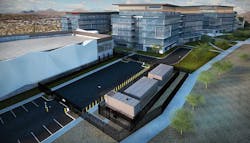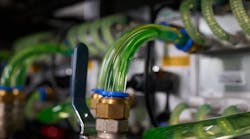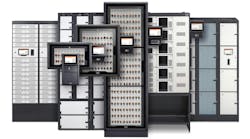Is the Midwest a New Silicon Valley? Here’s Why You Should Take Advantage of the Trend.
“Google kicked off the Iowa data center boom with its 2007 announcement of a new facility in Council Bluffs, which over the last decade has grown into the company’s largest cloud campus, with well over 1 million square feet of data center space deployed,” he wrote.
Cut to 2022, and we’re still seeing the Midwest in headlines as a tech capital. During President Biden’s March 1 State of the Union address, he congratulated Intel on its plans to build a $20 billion semiconductor “mega-site” near Columbus, Ohio. Santa Clara-based Intel helped to build Silicon Valley. As Rich Miller pointed out, this mega-site’s location in Licking County, Ohio “is also home to one the country’s fastest-growing clusters of hyperscale data centers.”
Choosing the site that best fits their requirements is a critical decision for hyperscalers and enterprise organizations, and it is not one that is taken lightly. Site selection is a strategic process that requires the right blend of power, cost savings, environmental conditions, and scalability. Uptime is also a priority, and as more companies adopt hybrid infrastructure, it is becoming more complex. It requires organizations to consider backup strategies that span cloud, colocation, on-premise facilities, and edge infrastructure.
So what key factors are driving hyperscalers and enterprise organizations to branch out of the densely populated fiber hubs and into geographically diverse Midwest locations? Here are some of the top reasons that, when it comes to colocation, disaster recovery and development sites, enterprises and hyperscalers have discovered that the American Heartland just makes sense.
The Price of Power
We know that a stable power supply is critical for companies that rely on data centers. Organizations need reliable power to enable and cool the IT equipment that allows them to remain operational. And because power comprises the majority of most hyperscale enterprise users’ total operating budget, the cost of power is one of the most important factors in data center site selection. Compared to competing regions, the Midwest delivers more affordable power, which quickly translates into cost-savings for colocation tenants. In addition, the cooler midwestern climate saves money in cooling costs. Data centers can leverage the cold winter temperatures, funneling in the outside air to cool IT equipment, making it an even more attractive location for colocation tenants. For enterprises and hyperscalers with high energy requirements, even a few more cents per kilowatt hour can mean tens of thousands of dollars in additional costs each year.
Scalability
Data center scalability is necessary to support increasing IT requirement demands, such as network and storage needs. Infrastructure needs can change quickly, and flexibility and speed of scale is a priority for enterprises and hyperscalers. They want to work with colocation providers with the ability and resources to scale up as quickly as possible to keep up with increasing needs and specifications. Data centers located in a dense urban area might not have the necessary real estate to accommodate fast growth. In the Midwest, however, land is not only more readily available, but also more affordable. This makes it easier for colocation providers to expand their footprint to accommodate growth.
Sharing the Wealth
To make states more attractive to data center investors and operators, many Midwest states have enacted tax incentives specifically to promote data center development. Those tax benefits are then passed on to colocation customers. Additional state programs further extend the savings for hyperscalers and enterprise operations. The Illinois Data Centers Investment Program Passed in late 2019, for example. This exempts data centers and their occupants from state and local sales tax on data center equipment purchases. These incentives are a win-win for data centers and their tenants.
Location, Location, Location
Intel’s mega-site outside of Columbus, Ohio and the suburbs of Columbus, Indiana may not look like technology hubs at first glance, but their proximity to Tier 1 cities like Chicago helps to reduce latency for high-bandwidth activities such as gaming and video streaming. Also, a rise in the number of climate-driven disasters related to climate change make the middle of the country a prime location for moving data between the coasts. Another consideration is the accessibility of the location, as well as the proximity to major cities. For disaster recovery purposes, a data center that houses your secondary and tertiary backups should be easily accessible to someone on your team, yet more than 30 miles away from a major metro area. These reasons, combined with cost savings and sprawling real estate opportunities, makes the Midwest an ideal disaster recovery location.
Peace of Mind
Anyone who has experienced mother nature’s wrath can attest to the stress that can come from natural disasters. Add in the IT-related financial consequences associated with natural disasters and it’s a price that many businesses simply can’t afford to pay. A study by Gartner estimates a businesses’ average cost of downtime is $5,600 per minute. This makes it easy to understand why, during the site selection process, operational leaders carefully evaluate locations based on climate, environmental conditions, and the probability of a natural disaster.
The Midwest’s central location puts the region at a lower risk for natural disasters such as hurricanes and earthquakes.
Hyperscalers (And Major Enterprises)
The cost savings, environmental conditions, and scalability benefits make it easy to understand why hyperscalers and enterprise organizations see the Midwest as a major opportunity. Watch out, Silicon Valley, a new contender just might be on the horizon.
Blake Proffitt is the Product Manager at DartPoints. He connects technology, business strategy, and product knowledge to identify solutions that meet customer needs and achieve business objectives. Contact DartPoints to learn more about their cloud, interconnection, colocation, and manages services.


